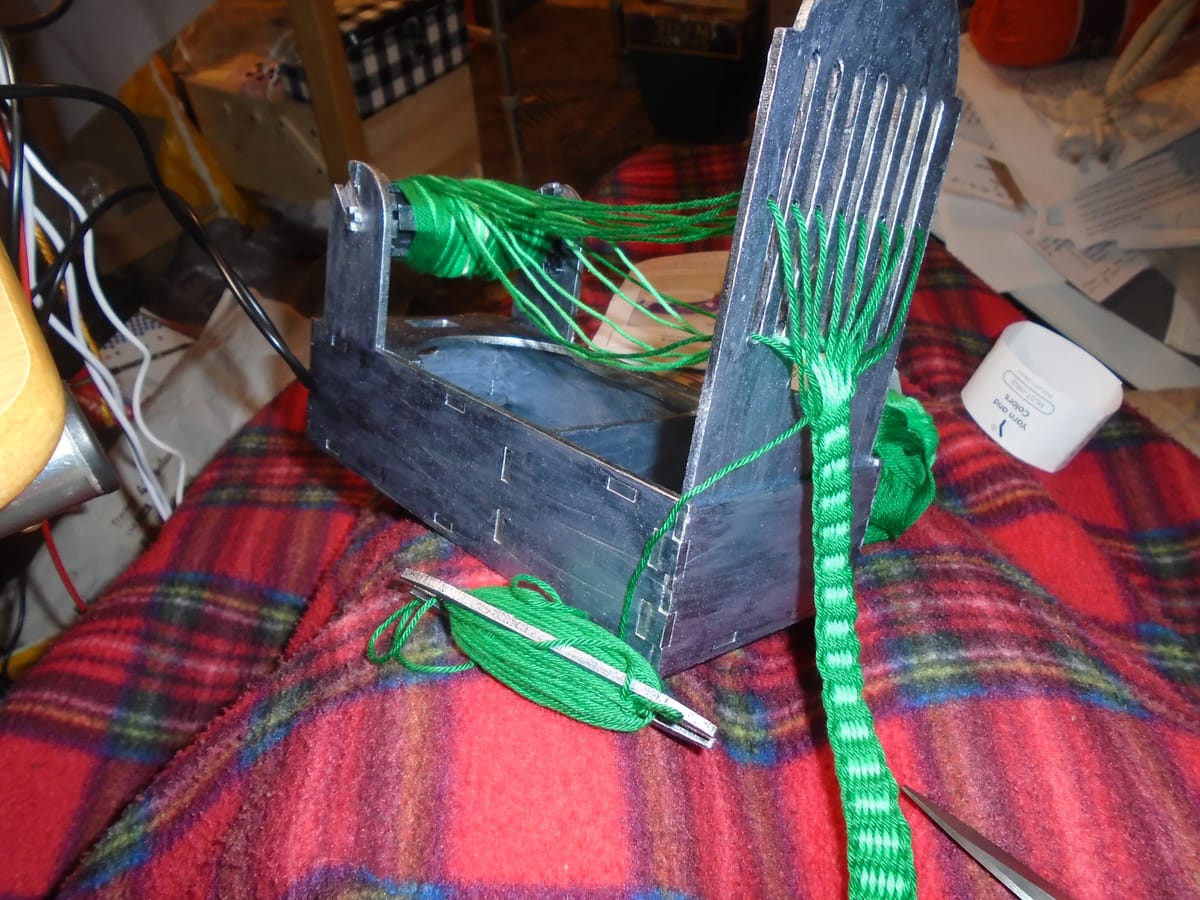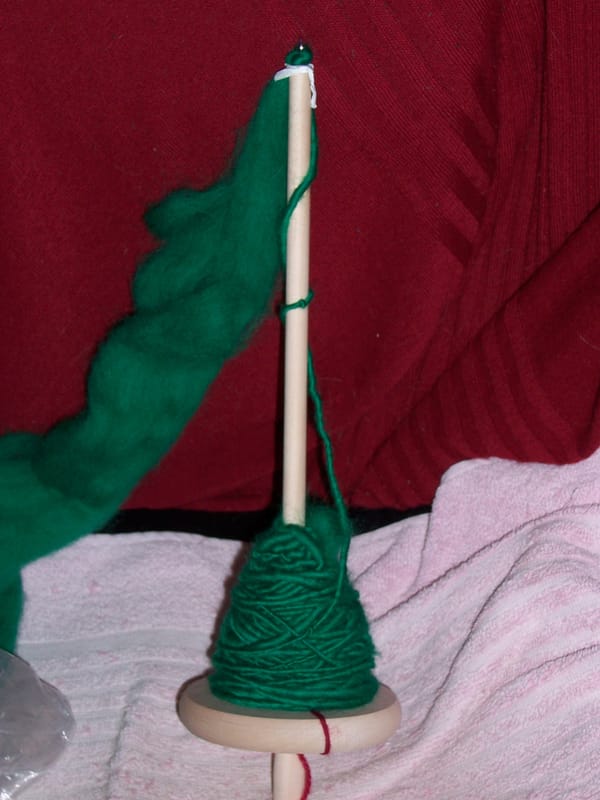Neat and trim

Well, she took a lot of painting; she and all her accessories got a full coat of Payne's Grey followed by most of a coat of silver (as in I didn't bother silvering the base, nor the inside of the roller, which is barely visible in use). The combination catches the flash a little oddly; the shuttle looks a lot more silver here than the loom does, but in fact they're both the same. And the heddle still fits into the slot, but it takes a little persuasion because the cutting was so very precise. I took the precaution of sanding down the lower parts of the edges before I did the painting, otherwise I don't think it would have gone in at all once painted; and I'm not at all convinced I have the strength to get it out again. Still, I'll cross that bridge when I come to it.
But now she's fully dry and ready for action, so, obviously, the first thing to do was to weave a practice piece of trim. I have a lot of Yarn and Colors Must-Have, because I wanted 4-ply so that I could combine two colours to make marled welts on DK pieces; but, as I may have mentioned before, it is not 4-ply, at least not in the UK sense of the term. The weight, in fact, is precisely equal to that of Paintbox Cotton DK. So, basically, it's a cotton DK; it's a nice one, true enough, but that's not what I bought it for. Consequently it does single-colour contrast welts, it does baby hats, and I thought it would do weaving on Gisele pretty nicely, too. As you see, it certainly does. (For the curious, the darker green is called Amazon and the lighter green Peony Leaf.)
Once the loom is set up as shown in the photo, the first thing you do is cut your warps. I didn't specifically measure them, it being just a practice piece, but they're about a metre long. The instruction booklet has details for several different warp-faced patterns, and I chose this one because I've done something very similar in the past using tablet weaving. (I am fairly sure that most tablet-woven patterns don't translate, or at least don't translate without a lot of work, to a regular inkle loom. With tablets you can very easily weave a diagonally striped braid, and I can't at the moment see how you would do this using Gisele; I suspect you can't, in fact, due to the limitations of the heddle. However, this one does.) It requires 10 warp ends in the darker green and 5 in the lighter green. You then need a couple of lengths of scrap thread, and as it happened I had some odd string lying about from the other day's netting practice, so that was easy enough. Hitch these odd bits of string over your roller, thread up the warps according to the pattern, then divide them into two bundles, knot them together, and tie each one to one of the odd bits of string, which are called guide threads. (I used clove hitches; and I'm extremely glad I did, because they are secure but also not hard to untie. When I first started weaving I discovered I'd left out one of the warp threads. I found it and threaded it on, but that obviously meant I had to unroll the whole lot, untie one of the bundles, re-tie it with the new warp in place, and then re-roll.)
Once you have your two bundles of thread in place, pull on the near ends of the threads till everything is nice and taut, then start rolling it onto your roller. There are little pegs for securing the roller firmly in position, but I'm finding there's enough friction on the roller that I don't need them. The other thing I found was that the outermost threads are somewhat inclined to slide off the body of the roller and onto the axle, which isn't ideal, so when I'm rolling I need to guide the threads inwards a little with the thumb and forefinger of the hand I'm using to do the rolling. (The other hand is needed to keep the tension on the warps at the other end.) Roll till you have just a fairly short length on the near side of the heddle, then tie the whole lot of warps together and you're nearly ready to go. All you need do now is wind some weft thread onto your shuttle.
The weaving technique is very simple, but it takes a little practice to get it even. (You can't see in the photo due to the angles, but in fact my piece isn't quite; it's close, and certainly not bad for a first attempt, but there are some small variations in the width.) With a lot of looms, it's the heddle that moves; with Gisele, the heddle stays firmly fixed and you move the warps up and down in front of the heddle. Raise the warps and pass the shuttle through the shed in one direction, then lower them and pass it back, pushing the edge of the shuttle against the previous pick and leaving a little loop of weft thread on one side. Raise the warps again, pass the shuttle through (again pushing against the previous pick), and this time gently pull on your new loop to tighten up the previous loop, drawing the warp threads together. Repeat as required. So all the weaving is actually done just in front of the loom, rather than on it. There also isn't a cloth roller to hold the tape you've just woven and maintain the tension. You do all that. This trim comes out about 13 mm wide, and obviously if you used a narrower thread it would be even narrower than that; you couldn't get away with very much wider, as it would be hard to thread a thicker yarn through the holes in the heddle. Having said that, I have some coloured jute twine coming (primarily for netting; I suspect a few unsuspecting people are going to end up being made string bags, and they might as well be interesting ones!), and if it's not too thick I think I'm also going to see how Gisele handles that. The one thing I won't be using is anything fuzzy. Too hard to thread through the holes, and I'm not crazy about the effect when woven.
The instruction leaflet also recommends linen, among other things. I was surprised by that at first, but of course it's obvious when you think about it. Gisele isn't a regular rigid-heddle loom, so she's not going to have the usual problem with linen. Because you're moving and tensioning the warps manually, you can get away with using something like linen which has no elasticity at all; in fact it's going to work really well. My linen thread is a great deal thinner than the cotton DK, so I'd expect it to give me a very delicate length of tape indeed - at a good guess, only about 3 mm wide. That's not an awful lot of use as a trim, but shall I tell you what it's perfect for?
Tape lace. And I haven't made that for years... because I couldn't get the tape. Craft serendipity strikes again.




